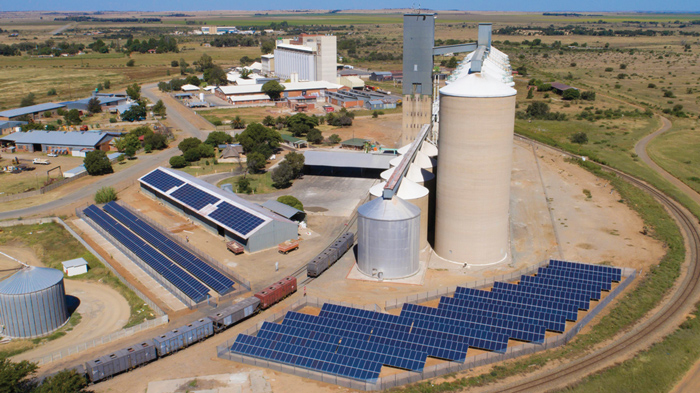Producers harvest the sun by utilising this energy to convert rainfall, inputs, and labour with precision and without interruption into valuable starches and oils. Storage operators store the harvest safely by utilising electricity generated from coal-fired plants distributed directly by Eskom or municipalities. However, the cost of storage is becoming exorbitant as the reliable supply of affordable electricity dwindles year after year. On 31 May, Agbiz hosted a workshop that brought together experts, agribusinesses and the mining sector to investigate how companies can secure their energy needs.
Electricity is vital for growth
Economic growth in South Africa is dependent on the availability of reliable and sufficient electricity supply and less on the cost of electricity, as primary industries have limited potential to reduce their consumption. The strong growth in primary agriculture in terms of production sustains an equally strong secondary agricultural sector. The manufacturing of primary agricultural commodities and products into value-added food, feed, and fibre products of value to the end consumer is the strongest growing sector in the manufacturing industry of our economy.
There is a close correlation between the availability of the surplus supply of electricity and the economic growth response of our economy. Economic growth and job creation are unfortunately directly constrained by the lack of available and reliable electricity supply. In our opinion, economic growth forecasts should be based on the future availability of electricity, as the latter is the most limiting factor impacting economic growth. In other words, optimistic economic growth forecasts can turn out quite wrong if the future availability of electricity is not taken into consideration.
Regarding the cost of electricity, the long-term forecast for electricity pricing in South Africa is largely dependent on demand. Should demand drop due to decreased economic activity caused by supply-side constraints, then South Africa will face significant challenges with rising costs. At the current path, it is expected that South Africa will face a 69% increase in electricity tariffs up to 2031/2032. This is equal to an average compound annual growth rate of 5,4%, which is significantly higher than the Reserve Bank’s inflation target of 4,5%.
Electricity supply – captured by municipalities?
Storage operators in rural areas either receive their supply of electricity directly from Eskom or via the local municipalities. A large number of the smaller municipalities are dependent on the income received from electricity sales. Municipalities want to protect their exclusive right to distribute electricity within their boundaries in order to bolster revenue collection. Unfortunately, some municipalities cannot maintain the electricity infrastructure sufficiently. Municipalities lost the expertise, know-how, and capacity over time and according to the South African Local Government Association (SALGA), Eskom does not pay for the municipal infrastructure it uses for the distribution of electricity. The revenue generated from electricity is used to cross-subsidise other municipal services.
SALGA argues that the distribution of electricity by Eskom (or third-party electricity distributors) within municipal jurisdictions will lead to an increased loss of revenue and of opportunity to generate revenue from the distribution of electricity for municipalities. SALGA has therefore gone to court to make an argument in favour of the exclusive right to distribute electricity within their boundaries or to receive the surcharge payments if customers do not source from municipalities. The outcome of the case will have a significant impact on the future supply of electricity within municipal boundaries.
Importance of electricity for grain storage
The sustainable supply of electricity to silo complexes, mills and feed manufacturers is very important. It impacts not only directly the rate of deliveries from the farm to the silo at in-loading, but also the rate of out-loading of physical stock to the consumer. In addition, storage operators must comply with minimum standards concerning the out-loading of stock to remain registered as a JSE delivery point. The main reason why the storage sector will consider an alternative energy source such as the more expensive generation of electricity by a solar installation or diesel generator, is because of the immediate need to supply stock without interruption to a nearby consumer such as a mill or feed manufacturer.
Silo complexes that were hit the worst by daily events (outages of electricity), reported up to 50 events of power outages per day. Currently, Eskom keeps to load shedding schedules and storage operators manage to operate efficiently within the pre-determined limits. However, storage operators that are supplied by municipalities do not fare as well as municipalities fail to keep to load shedding schedules. Plants incur raw material losses and increased labour costs. Power outages during load shedding impair security, with grain theft that is a great concern and on the increase.
Producers are demanding the delivery of grain at higher moisture levels. Consequently, the demand for energy increases for drying the grain as well – and bins need to be aerated by electric motors. Storage operators have the need to increase their capacity to produce electricity and to become self-sufficient in terms of energy. Electricity supply needs to be reliable to accept grain for safe storage without hold-up during harvest. Storage complexes that are supplied with electricity by municipalities are the first that need to consider moving out of the electricity grid. Some storage complexes have already registered between 50 and 100 electricity interruptions (voltage dips, etc) in the first month of the current marketing year.
Cost of solar energy in storage
The cost of electricity varies depending on the supply authority, tariff structure applied and demand and consumption profiles of facilities. Irrespective of the numerous challenges faced by Eskom, the cost of electricity for grain storage facilities connected to the Eskom rural distribution network with a time-of-use (TOU) tariff structure is fairly low compared to storage facilities connected to municipal distribution networks with a flat rate tariff structure. Thus a grid-tied photovoltaic (PV) solar installation is financially more achievable on municipal connected facilities compared to Eskom connected facilities. However, the power capacity and the quality thereof (insufficient and interrupted supply of electricity) by either Eskom or local municipalities, are forcing grain storage operators to investigate alternative sources of energy in the form of micro-grid solutions. Depending on the characteristics of each facility, alternative energy sources are not necessarily the cheapest option and an in-depth study must be done to determine the life cycle cost of energy (LCOE) of each considered facility.
It makes sense to start with improving the efficient use of electricity and to then work out the total costs and benefits of a solar installation based on the LCOE method of different scenarios. The payback period on solar installations is between approximatley four to six years and on battery installations between eight to twelve years, depending on the characteristics of the facility and installed system. The additional supply of electricity by third-party producers should in an ideal world lead to lower electricity tariffs. However, due to the fixed investment made by Eskom in electricity production (for example Medupi and Kusile power stations), and the condition and thus required maintenance of the existing transmission and distribution, a lower demand for Eskom electricity will rather lead to the costs just being recovered from fewer customers. Therefore micro-grid solutions will become more attractive due to the snowball effect over time.
To embed new generation capacity at silos come at a significant capital cost and it may not be economical to generate the full energy demand from solar installations only. The cost may vary significantly from site to site and the following information is shared as an example to gain a better perspective.
The cost to run a diesel generator is at R4,75/kWh (LCOE of R8,74/kWh) compared to electricity from the grid at only R1,80/kWh (LCOE of R5,72/kWh) and a combination of electricity from the grid together with PV equipment at R1,65/kWh (LCOE of R2,00/kWh).
Due to the technical nature of the available technologies, the different characteristics of each facility, the strategic objectives of each business and an energy industry that is not mature with many pitfalls, it is recommended to make use of a owner’s engineer to guide a business through the correct energy strategy by taking LCOE models into consideration.

The SALGA case
Agbiz Grain is of the opinion that it is of utmost importance that the outcome of the SALGA case should be in favour of holders of electricity distribution licenses and companies in the business of electricity generation, transmission, trading and distribution. The gist and purpose of this application by SALGA is to seek an order stating that municipalities have exclusive authority to reticulate electricity within their jurisdictions. The distribution and supply of electricity by Eskom in municipal jurisdictions amount to reticulation of electricity and the provision of a municipal service which requires a service delivery agreement to be entered into between Eskom and the respective municipalities, in terms of Section 76 of the Local Government: Municipal Systems Act (Act No. 32 of 2000).
On account of their executive authority to reticulate electricity, and their rights to govern the affairs of their communities, municipalities have the power to request Eskom to enter into service delivery agreements with the municipalities for the former to reticulate electricity within the latter’s jurisdiction. Agbiz Grain thinks that should SALGA win the case, it will be to the disadvantage of producers, storage operators and processors as municipalities may add a surcharge.
Concluding remarks
Energy supply should not only be affordable, but the supply also needs to be sustainable. In addition, there is a global energy transition from fossil fuels (coal) to renewable energy sources that coincides with digital transformation. The latter needs a sustainable supply of sufficient electricity and the demand for sufficient and reliable electricity supply will therefore increase at storage complexes. The storage sector’s basket costs are exposed to unique challenges and specific cost increases that are not yet fully reflected in storage rates. The availability and cost of electricity play an extremely important role in the storage sector and the weight of this cost item (excluding diesel cost for diesel generators) compared to the total storage cost is 13,1%. This cost item is expected to increase annually by an average of 5,4%, which is considerably higher than the inflation target of the Reserve Bank of 4,5%.
Storage operators keep a watchful eye on electricity as a cost item and will ensure that they recover the energy costs in their rates for storage sufficiently. In the future, the countryside may witness the development of solar energy plants that co-generate energy for a hub of say twenty storage complexes with their micro electricity grid completely off the grid. It may not only be the producer that will be harvesting the sun to turn its energy into starches and oils. Storage operators may have to follow suit to store the commodities safely and in a green manner.
This article was written on request of Dr Pieter Taljaard, CEO of Grain SA, and will also feature in the Agbiz Grain Quarterly in August.
Resources
- Case no: 46214/21, 2021., The High Court of South Africa, Gauteng Division, Pretoria, 14 September 2021. https://www.ee.co.za/wp-content/uploads/2021/12/SALGA-notice-of-motion.pdf
- Unpublished report, 2022. Lungiswa energy presentation: Agbiz – Rural rejuvenation workshop focusing on energy security, 31 May 2022.
- Unpublished report 2022. Senwes energy presentation: Agbiz – Rural rejuvenation workshop focusing on energy security, 31 May 2022.

















